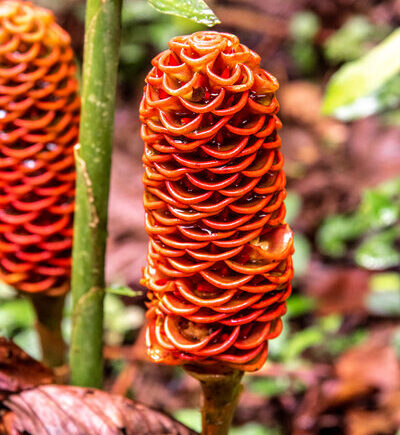By IL‘s Costa Rica Insider, Kathleen Evans, and Guest Contributor, Kacie Crisp
Here’s What to Expect When You Visit Right Now
By Kacie Crisp
Costa Rica opened on November 1 to travelers worldwide, including from all 50 U.S. states, without the need for a COVID test. You now only have to fill out a health questionnaire online, and provide proof of health insurance, to gain entry. If you have a proper mask (those white and blue ones that everyone and his brother hands out in the U.S. work just fine) and the Q code from your health questionnaire, then entering the country is straightforward.
If you’re up for it, it may be the best time in years to visit Costa Rica. The current opening reflects the timing of the tourist season and the economic necessity of it.
Reasonable COVID precautions are in place, and everyone is doing their best to return to business as usual. Handwashing stations and disinfectant will greet you at stores and restaurants, and your server in a restaurant or shop will be wearing a mask. You are required to do so as well, though you are allowed to take your mask off when you sit at a table, presumably because you are immediately eating or drinking.
The country used the period of the shutdown to beef up its medical facilities. The health insurance required to enter has to include coverage for two weeks’ accommodation in case you contract COVID and have to quarantine, as well as hospitalization costs in Costa Rica.
Since my recent arrival—my husband, David, and I have moved to Sarapiquí in the Heredia province—I can report that the crowds which can overwhelm some popular sights have not yet returned. “Opening up” in August consisted of five flights per week. Flights to accommodate 300,000 people have optimistically been scheduled for December. If those flights do materialize and arrive full, Costa Rica could return to its regular number of 3 million tourists per year by the end of 2021.
In addition to a warm welcome, there are bargains to be had. The largest craft store in La Fortuna, Artesania Costa Rica, on the road to the La Fortuna waterfall, offered 30% off for those paying with cash (USD gladly accepted, and change in dollars even provided). This large store offers everything from carved wooden bowls of all shapes and sizes to hammocks, and any other Costa Rica-themed item you could possibly think you need. We returned to the hammock maker on the side of the road, where my husband had already purchased one item, and we bought several others for friends at half price. His hammocks are made primarily from recycled polyester. The vendor, Daniel, who spoke very little English, told us that his business is contributing to the earth through recycling.
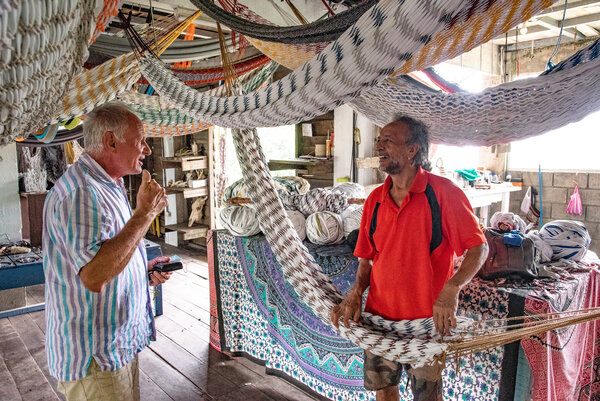
As in the U.S., not every business survived the COVID storm. I had picked out a restaurant in La Fortuna based on memory and the guidebook recommendation, only to find it shuttered, with no indication of whether it would open again or not. Friends staying at a rainforest lodge in Sarapiquí the second week in October were told they were the first guests at the hotel or restaurant since March. When we dine at our favorite restaurant in the Sarapiquí area, Tica Linda, we’re happy when we’re not the only customers on Friday night, and we feel we’re contributing to the local economy as well as enjoying delicious fresh fish.
On the weekend of October 24 and 25, we paid a visit to the Caribbean resort of Puerto Viejo de Talamanca—and it was packed, mostly with Costa Ricans eager to get back to normal by going to the beaches and restaurants. On the street, some wore masks, others didn’t.
If the traffic on the only road to the coast was any indication, everyone wanted to go to the beach on that weekend, the first weekend when ticos were allowed to drive on both Saturday and Sunday. The mood was celebratory—it felt like the first summer weekend at a beach resort. Our waitress told us it was the busiest it’s been since March, and it’s still very quiet during the week.
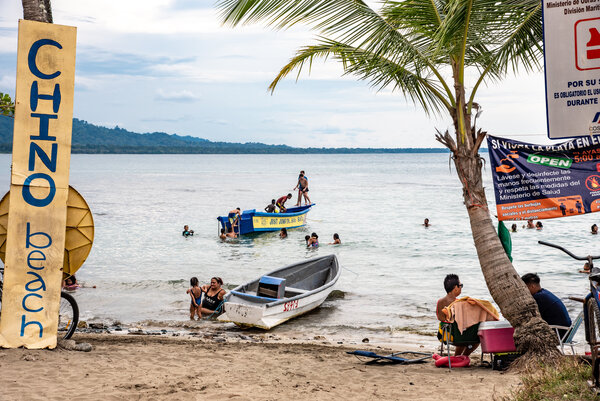
The following Saturday, October 31, it was quiet when we visited the tourist hub of La Fortuna. The highly recommended Rain Forest Café in town, a tourist and expat hangout, had only a few customers at 11 a.m. on Saturday morning.
We spent the afternoon at the Arenal Observatory Lodge, a lovely facility right on the side of the volcano. Two other parties were having lunch in its large restaurant, with spectacular viewing of the volcano itself (often shrouded in clouds) as well as local birds including toucans, colorful yellow-tailed oropendolas, and smaller colorful species. We encountered only two other parties—all Costa Ricans—while hiking through spectacular forest to the frog pond and gravity-defying observation tower.

The diverse natural sights of Costa Rica, of course, continue unabated—and now may be the best time ever NOT to have to share them with crowds. A spectacular raptor migration flew right over our house last weekend. Hundreds or thousands of vultures, hawks, osprey and other raptors, looking like tiny black ants as they are backlit against the sky, circle ever upwards on a thermal, shooting out at the end to glide onwards, hopefully to the next thermal for another ride. The Caribbean side of Costa Rica is one of the narrowest bottlenecks in the worldwide flight pattern of birds, and a million or more birds per day have been reported.
In addition to the animals you can spot in the wild, the country is dotted with rescue centers where you can see the local animals close up. Many of the folks who work there are volunteers, and these organizations depend on your entry fee and support to continue their good work of returning animals who can be rehabilitated to the wild, and caring for those who cannot.
Not only is it a great time to visit Costa Rica, for those for whom it feels right, but your contribution to the tourist economy of this small country may make more of a difference than ever.
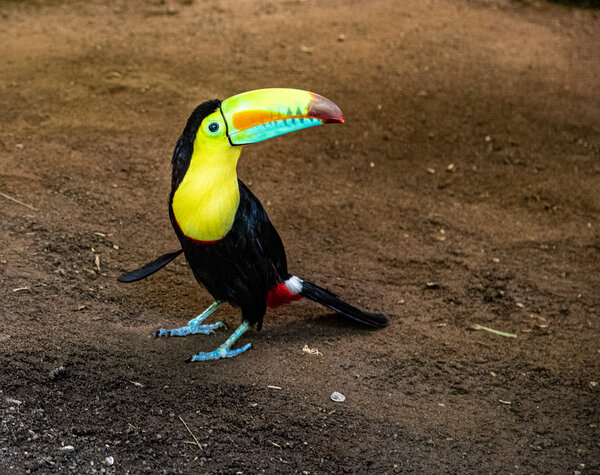
Sport Fishing in Costa Rica: The Quick Guide
By Kathleen Evans
“The charm of fishing is that it is the pursuit of what is elusive but attainable, a perpetual series of occasions for hope.” – John Buchan, Scottish Novelist and Politician
There is something about being out on the open water…the refreshing sea air…the gentle rocking of the waves…the deep blue teaming with life just below the surface.
Costa Rica boasts two coastlines, Pacific and Caribbean, totaling about 1,290 kilometers (801 miles) in length. This tropical Central American country is recognized as one of the top sport fishing destinations on the planet. Therefore, it is no surprise that 95 world-record catches have been made here.
When is the best time to fish in Costa Rica? The honest answer is there is never a bad time. Deep sea fishing and hidden freshwater fishing offer rewards and variety year-round.
Let’s break it down…
Pacific Game Fishing
The Pacific Coast is famous for offshore sailfish, marlin, dorado, wahoo, and yellowfin tuna. Inshore, roosterfish, snook, and snapper are most frequently reeled in.
September through November is usually the best time to catch marlin. However, black, blue, and striped Marlin are found all year. An experienced captain and crew will know how to target them. Yellowfin tuna is never a rare find on the Pacific side, and it’s not unusual to catch some weighing 100 pounds or more. The biggest are typically landed during June through September.
December through April are the best months for sailfish, but the expert captains will tell you there really is never a bad time in Costa Rica, since they’re abundant. Typically, the Pacific sailfish will be over 100 pounds. Dorado that gather in the weed lines inshore are best found during green season, June through October, and average 5 to 15 pounds. The larger dorado can be caught further offshore in deeper water during dry season, December to April.
Wahoo is a great surprise any time of the year. These fish are not usually targeted. However, they make a great bonus catch while trolling for tuna or marlin. Wahoo have razor-sharp teeth, so it is important to use wire leaders to bring them in.
Lastly, roosterfish are best caught June through October, but in reality, the bite is good all year. They range from 20 to 80 pounds and are fighters, so you’ll get a workout reeling them in.
The Caribbean Variety
On the Caribbean side, tarpon are found in the winding canals and lagoons of the Tortuguero River in Costa Rica’s northern Caribbean near the national park of the same name and the wildlife refuge. Another popular catch is snook, considered some of the tastiest fish in the country. The snook season parallels the tarpon season, the best time being late August through October. Snook can be caught offshore, in the lagoons, and shore casting.
On the Caribbean side you could also snare jack, dorado, snapper, and even Atlantic sailfish—although these are rare.
Freshwater Feasting
The Tortuguero area is also home to several freshwater gamefish species, such as the guapote or rainbow bass. This breed is kind of a cross between a bass and rainbow trout, although not actually related to either. They are found in the jungle lakes, lagoons, and rivers. Machaca and mojarra are also typical in the area, but are much smaller.
Tortuguero is not the only area for freshwater fishers. Costa Rica has hundreds of miles of inland rivers and a handful of lakes that always provide abundant fishing. Costa Rica’s largest and most popular inland lake, Lake Arenal, is located four hours northwest of San José. Rainbow bass is the best catch found there.
Lake Coto, north of Arenal, and Caño Negro Lagoon in northern Guanacaste, are other popular freshwater fishing destinations. They’re all in the same general area, making it easy to do a weekend excursion.
Ask an Expert
I had the opportunity to learn more about sport fishing from a couple of Costa Rica’s expert expats, Steve and Lisa Quinn from the tiny town of Buckhorn in Ontario, Canada. They moved to the Tamarindo area on the Gold Coast full-time in November 2010, having fallen in love with the country. They’d been regular visitors since 2004.
Too young to retire, they owned a restaurant and then a B&B, both of which they later sold on.
“We also bought Go Fish Costa Rica in 2012 off a couple friends that started it. At that time, it was simply a tour company that complimented the B&B.” Today it’s ranked as Tamarindo’s #1 sport fishing operation by TripAdvisor.
All boats are priced differently depending on the size and how long the charter is booked for. A half-day on a 27′ Panga for up to six passengers costs $425, but this moves upwards of $1,650 for a half-day on a 44′ Hatteras for up to eight passengers. Full days vary from $675 to $2,150+ depending on the boat.
I asked Steve to tell me about the variety of fish you can typically catch on the northern Pacific side.
“That depends on whether the clients are going offshore or inshore. Most people coming from other countries are coming here for marlin and sailfish and they can be found pretty much anytime of the year,” he says. “Inshore is usually limited to a half-day charter and you can catch snapper, grouper, Jack Crevelles, and the sought-after roosterfish. People will come year after year to try to catch these.”
I have personally caught a roosterfish. They make for a spectacular photo opp with their lovely rooster combs!
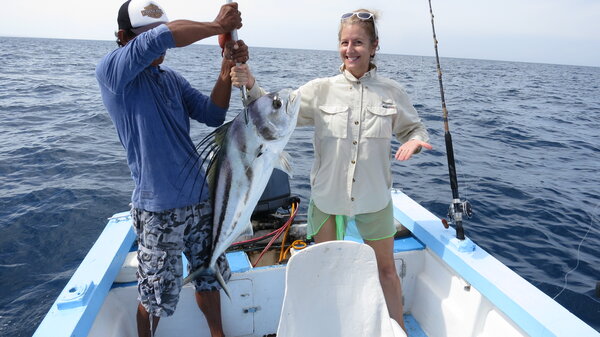
I checked in with several expats for sport fishing company recommendations in their respective regions.
Here are some resources, based on the coastal area you will be visiting:
Guanacaste Gold Coast (Tamarindo): Go Fish
Guanacaste Gold Coast (Playas del Coco): Dream On Sport Fishing
Central Pacific Coast (Los Sueños/Jacó): Maverick Sport Fishing
Central Pacific Coast (Quepos/Manuel Antonio): Jackpot Sport Fishing
Southern Zone (Uvita): Bahia Ballena Kayaks and Sport Fishing
Caribbean Side (Puerto Viejo): Wahoo Fishing Tours
In most cases, it is your responsibility to purchase your fishing license, unless your tour company confirms that it is included in your trip. Here is a link where you can find the Costa Rican Fishing License.

